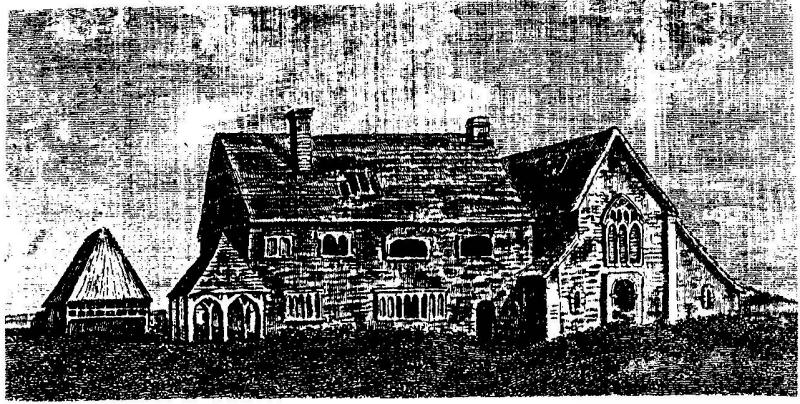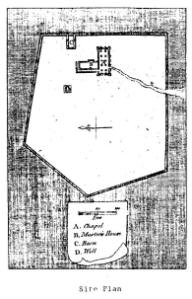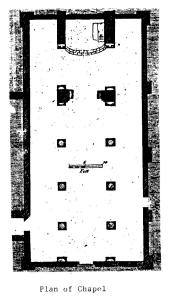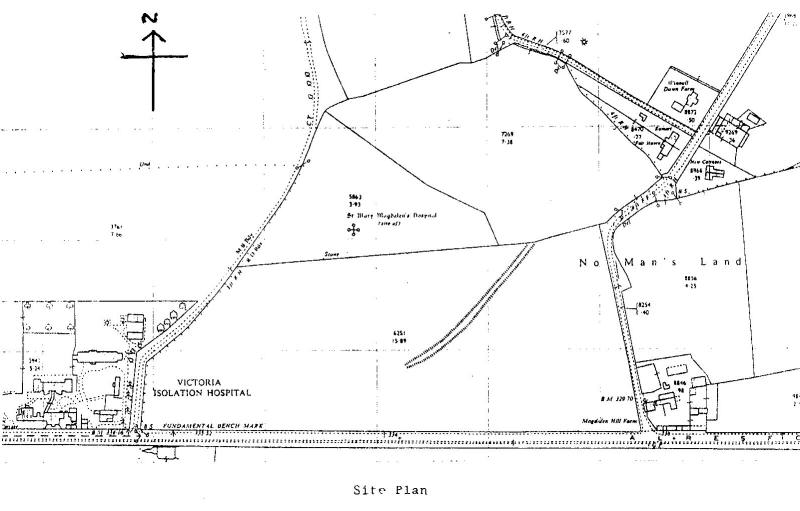NO. 83 - THE HOSPITAL OF ST. MARY MAGDALENE.
by Raymond Elliott.

Site of the Corporation or the Master, Brethren and Sisters of the Blessed Mary Magdalene Hospital near Winchester erected in 1148 and demolished in 1772.
In the Winchester Survey of 1148 printed in Domesday Addetamenta it is recorded that an annual rent of 10 shillings was paid from a tenement in Jewry Street, Winchester to "lepers on the hill", Also a commission was appointed by Bishop John of Stratford in 1333 to enquire into certain matters connected with the hospital of St. Mary Magdalene, which had been founded for the poor and sick, and that Henry (of Blois) brother of King Stephen gave £25.19s.6d a year from the episcopal treasury to the hospital Winchester Cathedral Chartulary, Also from early times, other annual payments, including £7.1s.4d paid by the priory of St. Swithun's out of the Manor of Hinton Deanery, 60s by the bailiffs of the City of Winchester and 22s by the Abbot of Hyde.
 The Corporation of the Master, Brethren and Sisters of the Blessed Mary Magdalene", near Winchester, was founded on the eastern hill in remote antiquity for lepers. A pension from the Bishopric of Winchester was granted by Henry de BIois, .and pensions from St Swithuns Priory and from the Crown were also paid from ancient times. The lepers on the hill were also mentioned in a Survey of the City of Winchester in AD 1148.
The Corporation of the Master, Brethren and Sisters of the Blessed Mary Magdalene", near Winchester, was founded on the eastern hill in remote antiquity for lepers. A pension from the Bishopric of Winchester was granted by Henry de BIois, .and pensions from St Swithuns Priory and from the Crown were also paid from ancient times. The lepers on the hill were also mentioned in a Survey of the City of Winchester in AD 1148.
Again, in 1545 we rind that King Henry VIIIs commissioners confirmed to the Court of Augmentations that "the hospital of Mary Magdalene nighe Winchester was founded by the Bysshopp of Winton as it is supposed"" Also "we know that the hospital was in existence in 1148 and that Henry of Blois instituted an annual payment to it from the bishopric". The portions of the brethren and sisters were augmented by the donations of the Crown and the Abbot of Hyde and by the projects of land and sheep belonging to the hospital. Offerings on the feast of St. Mary Magdalene (July 22.) were used for the upkeep of the buildings.
The lepers on the hill were mentioned in a survey of the City of Winchester in AD 1148. Leprosy was a very common disease in the middle ages and as late as 1420 the steward of Winchester College left money "for distribution among the lepers or St. Mary Magdalene".. The disease however gradually died out and the hospital intended at first mainly, if not exclusively, for lepers continued to serve the needs of the poor and infirm.
 Generally the accommodation included a row of almshouses, a handsome church linking together with the masters house, all enclosed by a high brick wall. The chapel is described as being 77ft x 35ft 6 ins east to west, with north and south aisles 8ft 10-ins wide extending to full length of nave and chancel. On the chancel walls were paintings one of which was probably of the Martyr of St. Thomas of Canterbury, This painting, together with the transitional architecture of the Chapel suggesting that Richard Toclive. was the founder of the hospital, probably in atonement for the part taken by him in siding with Henry II against Becket. This suggestion, stated as an historical fact, by some writers, is incorrect, since, the charity was in existence long before Bishop Toclive's time, but he may have built the chapel.
Generally the accommodation included a row of almshouses, a handsome church linking together with the masters house, all enclosed by a high brick wall. The chapel is described as being 77ft x 35ft 6 ins east to west, with north and south aisles 8ft 10-ins wide extending to full length of nave and chancel. On the chancel walls were paintings one of which was probably of the Martyr of St. Thomas of Canterbury, This painting, together with the transitional architecture of the Chapel suggesting that Richard Toclive. was the founder of the hospital, probably in atonement for the part taken by him in siding with Henry II against Becket. This suggestion, stated as an historical fact, by some writers, is incorrect, since, the charity was in existence long before Bishop Toclive's time, but he may have built the chapel.
In 1440 it is recorded that the bishop's grant to cover expenses and costs was divided into eighteen portions, of which the master took four portions. The remaining fourteen men and women each received 5 ¼d a week for food and 6s 1d annually for clothes. There, were ten pensioners who each got 3d a week for food from the benefaction of the Cathedral Priory, doled out on Sundays, adn three, weeks at ¾d a time, and "by the grace of the prior and convent and for the love of God" they received an occasional present of old clothes.
The troubled times of the Reformation did not greatly affect the hospital. The value of money however, had gone down and the commissioners of Henry VIII only found nine almspeople. (four brethren, four sisters and one pensioner) who shared the sum of £19.17s. 4d between them, while the master had £l3.9s.4d after paying necessary charges and out of this sum he had to maintain the buildings.
Far worse disasters were to befall the Master and Almsfolk in the seventeenth century. The western forces of the Royalists in the Civil War were described by Chareolon to be "such as their friends and their enemies laughed at being only humble in plunder, and resolute in running away". When these troops came to the Hospital of St. Mary Magdalene they forced their way in and plundered. A number of sheep belonging to the hospital were killed, quantities or corn stolen, burnt the great gates and almost all the timber they could find, made havoc in the chapel and stabled their horses in it.
A petition from the Master, brethren and sisters was presented to Lord Hopton praying that he would "give order for the reparation of the ruins....and that they might be settled in such condition as formerly". In reply dated 19th March 1643/4 the General desired two gentlemen to consider this petition and to take such order for the poor people's belief therein, as to them should seem expedient".
 For upwards of twenty years after this the Almsfolk remained undisturbed.
For upwards of twenty years after this the Almsfolk remained undisturbed.
Then came the Dutch War in 1665 and a royal mandate commanded that the Master move out of St. Mary Magdalene with all. his people down into Winchester, to allow suitable accommodation to house the Dutch prisoners of war. The move was to be at the King's expense and in any case only a temporary arrangement.
However, when the Dutch prisoners vacated the premises it was then found that those occupants had left behind tremendous destruction to all the buildings. The total cost of reinstating all the work amounted to a sum of £650., but the allowance made by the Government amounted only to £100., and in these circumstances it was found impossible to go back to the eastern hill. and the Master. Brethren and Sisters became homeless.
So in 1671 Dr. Dayrell, being the Master, secured tenements in Colebrook Street, Winchester for the Almspeople or for such as cared to live in them, the remainder receiving pensions. In due course six new houses were built in Water Lane, Winchester for the use of the. Almspeople.
In 1788 the then Master applied to Bishop Brownlow North for a commission to consider the state of the old hospital buildings on the east road from Winchester, The commission made a survey and declared them to be in a ruinous state and "it was judged expedient that the whole should be taken down". This was in June of that year.
An artist. Mr. J. Schnebbelie. hastened that summer to make sketches of the doomed hospital before the builders to whom the materials were sold began their work of demolition. Dr. Milner managed to save one doorway. which he re-erected at the entrance of the old Roman Catholic chapel in. St. Peters Street; it now stands on the north side of the present church, Mr. Schnebbelie's pictures, two large drawings of the interior of the chapel, from the east and west respectively, together with eight small sketches were engraved and published in 1790 by the Society of Antiquaries, volume three of Vetusta Monumenfa with a description and history of the hospital.
In Water Lane, Winchester in 1929 stood six alms houses belonging to the ancient corporation of the Master; Brethren and Sisters of the Hospital of St., Mary Magdalene where three men and three women supported by the charity, and in addition there were two out pensioners. The corporation maintained its old constitution untouched from the 12th century down to the summer of 1925. The master ship was a freehold held by a Church of England clergyman appointed by the Bishop of Winchester; and the Master himself appointed a steward, administered with his help the funds of the charity, and maintained the eight almspeople.
In 1925 however the hospital was assimilated to the modern constitution of St. Cross, and later, through an Act of Parliament.
The eight hundred, year old. corporation has since been dissolved and it is proposed to build six now modern almshouses in Mants Lane overlooking the Weirs at Winchester, which will bear the name of St. Mary Magdalene.
© Raymond Elliott February 1994
Sources.
J Schnebbelie Vetusta Monuments
Winchester Library 1790
